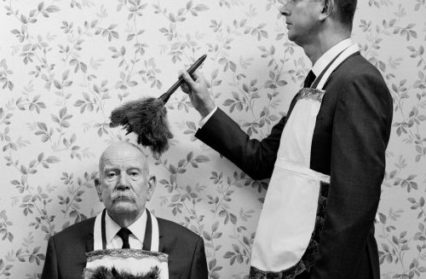Cerys-Leigh Phipps reviews What is lost… what has been by artist John Paul Evans, who described his solo exhibition at Cardiff’s Ffotogallery as a visual soliloquy to absent friends.
Gender, sexuality, family and memory – and their everchanging relationship with photography – are the driving themes of the photographs in Ffotogallery’s latest exhibition, What is lost… what has been. A celebration of the work of the Welsh photographer and artists John Paul Evans, it brings a number of Evans’ collections under one roof at the gallery in the Cathays suburb of Cardiff.
Spanning themes including loss and acceptance, gender representation and LGBTQ+ relationships, there are clearly a number of influences behind this thought-provoking and emotionally intense exhibition. Evans intertwines his relationship with partner, Peter, through the majority of the collections on display – with either often the focus of the camera’s lens. The inclusion of his personal experience via such intimate shots allows the viewer into the photographer’s vision for his pieces and his physical relationship, lending the collections rawness and intimacy, and bringing substance to the issues his work tackles.
The works of gender theorist Judith Butler, and her work surrounding gender performativity, play a vital role in the composition of the exhibition, as Evans openly discusses her ground-breaking work as a source of inspiration for the collection “Maritime Adventures”. The influence of this gender theory flows through the collection as Evans and his partner are photographed dressed as sailors. This pays homage to the role of the sailor in the work of 19th century American novelist Herman Melville, which Evans has described as having a “particular resonance through the centuries for same-sex attraction”. As well as a celebration of an artists’ work, this collection also serves as an education on the history of gender performativity, sexuality and politics, which are brought into sharp focus by Evans’ camera.
There is a reoccurring melancholy in Evans’ work, reflecting the gravity of the issues he chooses to shine a light on. Many of the photographs spanning his collections are in black and white, and when they are in colour they are almost always muted, with a heavy use of shadows and darker shades. Where Evans and his partner appear in photographs, they barely embrace and remain expressionless. These aesthetic choices leave a lasting impression via their honest portrayals that expose hardships but also engender curiosity and open the door to the wider debate around gender politics.
While speaking with Evans, it becomes quickly clear that he is an artist passionate about the issues he presents in his work. One collection that draws the attention of the viewer almost instantly is entitled “Today’s Lesson”. According to Evans, the vision behind the sixteen-photograph piece was to combat the homophobic scriptures that are commonly found in the bible with juxtaposing images of him and his partner expressing love, whether that be simply holding hands or symbolising relationship milestones such as buying a home together. Through this sequence, Evans captures both a sense of defiance but also sorrow, as the couple appear monotonous in each photograph. The black and white images evoke the hardships that come with a simple love like any other – beautifully yet tragically captured by Evans. The title “Today’s Lesson” becomes very fitting the more the piece is observed as the viewer gets an education in the reality of same-sex love, even in the modern day. This piece is truly a show-stopping collection which takes centre stage at the exhibition. John Paul Evans’ work is full of love, resilience, and exposure.
See more about John Paul Evans here.
To find out more about upcoming events at Ffotogallery in Cardiff visit their website.
Cerys-Leigh Phipps is a regular contributor to Wales Arts Review.












